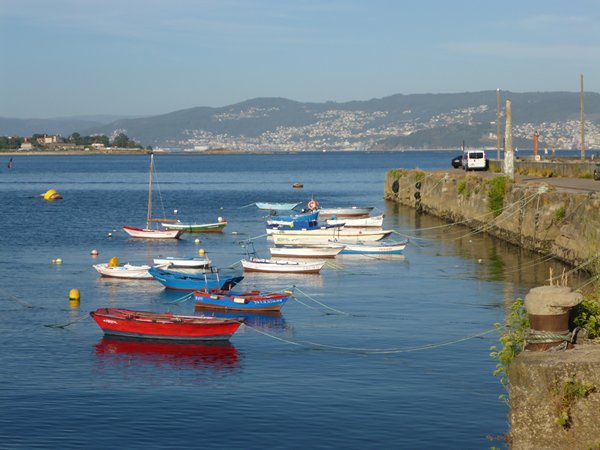28 Jul 2015
42:15.63N 08:46.95W Cangas Marina
Zoonie took us on another lovely sail under genoa passing derelict canning and whaling factories to Cangas marina where welcoming hands helped with our lines. Within no time the marina washing machine was busy with the dark coloureds while we planned our stay around a trip across the ria to Vigo on the half hourly ferry (like the Isle of Wight) a walk all around Cangas shopping big time as we were running low on essentials like uht milk etc and any other ideas that came to mind, and they did.
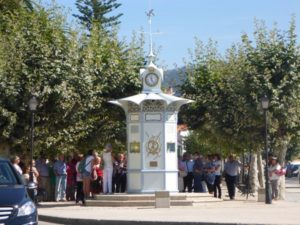
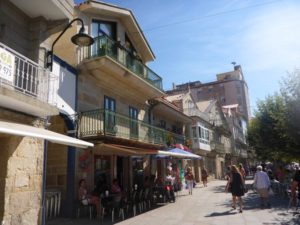
The marina, started by altruistic locals in 1981 who could see the needs of the people of Cangas to learn water based skills, is located right in the middle of the harbour area and centre of town. A short paddle board away (if we had them) is the ferry dock for Vigo and the islands, with the bus station and taxi rank alongside. The main roads are forty minutes from the airport that caters for internal flights to all the main Spanish International airports; so perfect for links to the UK.
We arrived to the sound of rockets, some welcome, the ones that made us jump not so! A man had emerged from a grey modern hatchback on a slipway by the harbour. He opened the back up and took out a big box of rockets, laying it gently on the concrete slip. (I wondered if he had managed to get car insurance). He then proceeded to take one at a time from the box, light it while holding it in his hand, then as soon as it started to whizz he let it go up with a whoosh and bang. He did this at irregular intervals 25 times over the next hour or so and at first Rob jumped every time, but his survival instinct kicked in and he listened for that whoosh so he was ready for the bang!
Within minutes of arrival we had wandered ashore and stumbled across the Patron Saint James Day procession making its very solemn way from the Cathedral Santiago de Cangas on a circuit through the town and back for a service at the Cathedral. The fine wooden carving of St James (the Moor slayer) was carried shoulder high by six stout men while the followers were dressed in pilgrims attire of brown, round brimmed hats (now the Panama hat) with brown cloaks, scallop shell motif on the shoulder and assisted with wooden staffs. The faithful procession swayed from side to side as one to the beat of a drum and bagpipes. I got the impression this was an act of faith and not laid on for any commercial reason. Older folk were dressed smart and attractively for the occasion and children held the hands of their subdued parents.
The flower filled cathedral was packed for the service presided over by Saint James. We squeezed in for a moment, that was quite enough for Rob and I hoped we could come back later for a closer look at James, but the massive doors were locked. The cathedral is located on the Rua Santiago, pilgrims’ route to Santiago de Compostela. In 2013 over 218,000 folk signed up to do the last 100 km to the most famous Christian pilgrimage destination in the world and receive their compostela, and the numbers are growing. A devout form of keep fit. All based on an apparent apparition……
James was son of Zebedee and Salome and brother of John. He was one of the first disciples to join Jesus and was present when Jesus ‘walked on water’. James taught about Christ in the Holy Land and in this Iberian part of Spain, he may even have ventured as far as the UK as did his brother. However it was at the battle of Clavijo here in Spain that James is thought to have appeared and helped the Christians slay the Muslim Moors. So much for preaching love and human understanding. End of lesson!
James was beheaded by Herod in 44AD (some think his fiery temper got him into trouble) and his body was brought ashore at Padron just north of here and taken to rest at Santiago de Compostela. From then on he became the patron saint of Spain and many other catholic parts of the world. A nineteenth century papal Bull (Pope’s word) declared the remains to be those of James. DNA analysis… hmmmm, but just maybe.
That evening we went for a wander along the shore line beside where we came in. The Masso name was a big family whaling business started by two brothers. We walked past the now derelict factories. First was the massive iconic Masso canning factory which stands out for the attempts to preserve it as part of history despite much of its roof having collapsed. It now has white metal screens protecting its outside walls, a high wire sectioned fence prevents the spraying of graffiti and a fine new promenade continues on past it.
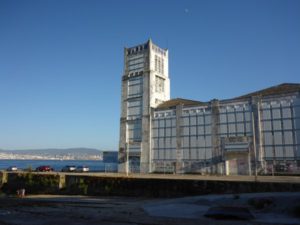
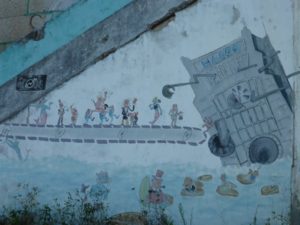
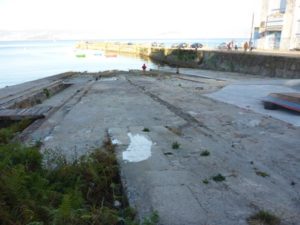
The wide slipway is a haunting reminder of the final destination of the intact giant sea creatures before they were hacked, processed and rendered down into oil. Every part of them was used, first the blubber for oil, then the flesh for food, the skeleton for umbrellas and corsets and other parts for medicines and perfume fixatives. The whale factory closed in the 1980’s after the International Whaling Commission was successful in getting 23 out of 30 of the world’s countries to ban the practice. Even the harsher, cruel aspects of history should be preserved for posterity, for the teaching of new generations. At the time they were fishing the seas, whether for sardines, cockles or whales, to make a living, unlike today’s whaling for fortune and ‘science’, in the full knowledge of the detrimental effect on the species.
In Vigo next day we learned there is a Masso Museum in Bueu, back across in the Ria Pontevedra, so that will be another excursion by bus.
29 Jul 2015
42:14.00N 08:45.00W Vigo next then.
Well that’s a bit of a cheek really because instead of moving Zoonie we took the ferry across and we’re glad we did. We knew beforehand that these city marinas are often filled with the vessels of nationals, leaving little or no space for foreign visitors like us. When we docked at the ferry terminal next to the central marina of the three, we noticed an uncomfortable swell causing the yachts to bounce and pitch and pop their fenders so we were glad Zoonie was tucked up safely in friendly Cangas.
So finally for me 30 years after I was first asked “Vigo next then?” by the Corunna fisherman, I have made it to this interesting place. The Romans favoured it, building many hill forts with their accompanying ‘urban’ camps all around here. We climbed to the top of the hill that is now part of the city and can see why this was such a good place to defend the city from as it had excellent clear views all around to spy on approaching marauders.
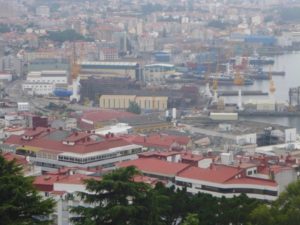
Back down the slopes we viewed artworks in two galleries, the second recommended to us by a lady in the first one. Galicia and in particular Vigo over the last 500 years were depicted by Galician artists. If the value of the paintings was in direct proportion to the size of the holstered gun worn by the lay attendant then they were worth a penny or two.
It was interesting to notice how the painters in the last 150 years have followed their contemporary movements like Cubism, impressionism and abstract art and yet the link was not made to the art movements in the descriptions. Rob favoured the portrait, land and seascapes as they showed just how Vigo has grown as a port from fishing village to a 3.5 km dock frontage where vast car parks of new, imported cars await distribution and two luxury cruise liners can dock at the same time.
A wander around the well preserved old town and light lunch in the Praza Constitucion concluded our visit before we returned home.
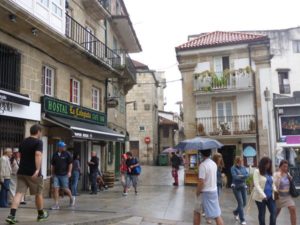
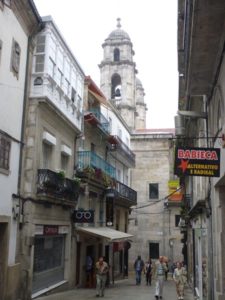
27th July
First job of the day was shopping, the first big shop for non-perishables since Plymouth. Armed with our black and white polka dot trolley we trundled off to Eroski at one end of town and filled up with cartons of wine, fruit juice and milk plus some fruit and veg before we off loaded onto the boat and then trundled to the Eroski at the other end of town because it is by the fish market.
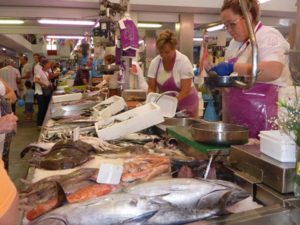
All that effort demanded some refreshment at the Club Nautico Rodeira by the marina where we met an English lady and her Vigo husband who have lived locally for 20 years and were in the process of moving back to the Salisbury area of the UK. Remember Larry, well this couple had just sold a Camper Nicholson boat from the younger family of designers based in Portsmouth. I felt a little sorry for the man, who loved sailing. First his boat gone and now leaving his birthplace.
The tapas at the Club are worth a mention. We counted seven different types; sardine with balsamic cherry tomato and pan (bread), vegetables with a poached quail egg in the middle and pan, spanish omelette (tortilla) and pan, crab sandwiches, fish croquettes and pan, ham and potato tart and grated tetilla (local cheese shaped like a bosoms hence tetilla meaning tits) on pan. All these would be served at different times on the same day. Best leave here soon or we’ll be different shapes when we do.
We had fish for supper with some of the green pimientos I have mentioned before but oh dear that was a disaster. Our Pilot book mentions that sometimes a hot pepper ( a fiery Padron like St James’ temper) can be mixed in with the mild ones. Well up to now we have been lucky but this evening we were eating the ones from Eroski. Suddenly poor Rob gagged and started to choke with an extremely violent reaction.
I was reminded of a similar incident when we first met and I accidentally made a curry with a whole bottle of curry paste (very condensed curry spice) because I thought it was sauce (much less concentrated). “Oh no, we’ve only just met and I am killing him already!” I tried a tiny bit from a few more pimientos until I too had a flaming tongue and pulsating skull and heart! I’ll try and give the rest to the marina lady.
After supper a long walk around the bay and effectively half way back to Vigo rounded off the day.
28th July, Bueu and the Masso Museum.
Only 3.20 Euros each return bus fare and free entry to a fine museum; they know how to do a day out in Spain. The coach ride gave us a thorough look at the nature of the land, countryside and human impact on this pretty and hilly area. The museum reflected the lifelong interests and passions of a few of the Masso family. Their canning businesses started in the 1920’s in numerous factories in Spain and continued until the nineties, the one in Cangas closed in 1995. The whale processing ended in 1985 with the IWO ban.
Apart from all the exhibits related to their business which carried out all the processes including making the tin cans, the black and white still photos and movie films made by the Masso family are a fine record of their industry. Staff in the massive factory here were photographed ‘at work’ wearing their Sunday best and sitting still for minutes as that is how long it took to expose their images on glass plates. So although the staff were genuine, because these pictures were used to promote the business they had to be carefully planned and not taken immediately as modern cameras allow us to do.
Video film of a successful whale hunt was, I guess, necessary for a complete understanding of the subject. On a happier note the days when 23,000 whales a year were taken from the seas are well gone.
Finally, on the museum, the Masso family also had a lifelong interest in the history of navigation and a whole room is dedicated to actual 500 year old manuscripts by the likes of Ptolomeo and model wooden sailing ships, navigational instruments and marine paintings. There were staff working in the offices on exhibits and excavations into the nearby roman sites are on-going. A place where you could carry out research work using all these genuine and original resources. And free entry!
We lunched in a green tilled bar watching a silent sports channel, making up our own commentary on the cycling and swimming events, before the return 40 minute coach ride.
Last evening we sat in the cockpit and watched all that was going on around us. The sailing school is busy all day. Children as young as seven can spend a week learning sailing for 20 Euros, 35 instead of 40 if their sibling learns with them. Young children carrying their own mast and sail or pulling the trailered dinghy to the slip then launching it are given control over what they are doing and learn all the quicker.
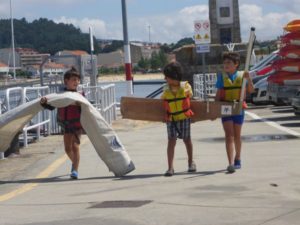
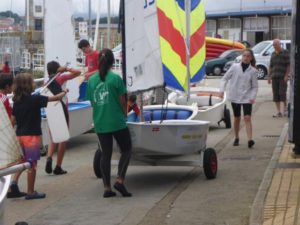
When they have tucked their boats away they are back at the harbour wall or along the pontoon, daring eachother to jump into the water. A young girl in red bikini bottom and pink top is making a display of her fear and this goes on till all her friends are in and she is shamed into taking the plunge.
As the evening draws on the youngsters are replaced by a team of 12 young men carrying a big upturned canoe down to the pontoon from the shed, turning it over and launching it for a two hour practice row. Then into the darkness elderly men and women fish with rods and chat together as the light fades.
